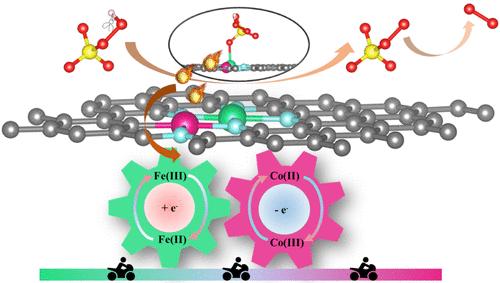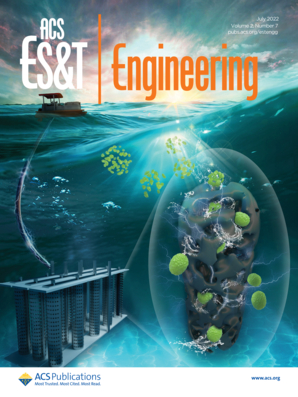植物多酚驱动的聚合-强化战略:超高负载原子分散铁钴双金属催化剂用于单线态氧主导的类芬顿反应
IF 7.4
Q1 ENGINEERING, ENVIRONMENTAL
引用次数: 0
摘要
最近的研究进展使碳封闭过渡金属催化剂成为芬顿类反应的有效催化剂。然而,在碳载体上实现过渡金属的高密度负载和良好分散的稳定整合是一项重大挑战。在此,我们介绍了一种植物多酚驱动的聚合-封闭方法,用于合成高度分散的铁钴双金属催化剂(FeCo@NGB)。利用茶多酚与金属离子的螯合作用以及随后的聚合和封闭为稳定铁钴双金属位点提供了一种持久的解决方案。由此产生的 FeCo@NGB 在激活过一硫酸盐(PMS)以快速降解四环素(TC)方面表现出卓越的性能,主要通过单线态氧(1O2)驱动的途径,仅在 30 分钟内就实现了 99.5% 的降解。实验和理论计算突出表明,原子分散的 FeN4-CoN3 位点在促进催化剂和 PMS 之间的快速电子传递方面起着关键作用,从而提高了 1O2 的产生。这项工作不仅推动了高性能多相催化剂的发展,还为利用非自由基氧化途径进行水净化提出了一个引人注目的策略。本文章由计算机程序翻译,如有差异,请以英文原文为准。

Plant Polyphenol-Driven Polymerization-Confinement Strategy toward Ultrahighly Loaded Atomically Dispersed FeCo Bimetallic Catalysts for Singlet Oxygen-Dominated Fenton-like Reactions
Recent progress has brought carbon-confined transition metal catalysts to the forefront as effective agents for Fenton-like reactions. However, achieving a stable integration of densely loaded and well-dispersed transition metals onto carbon support poses significant challenges. Herein, we introduce a plant polyphenol-driven polymerization-confinement method for the synthesis of a highly dispersed FeCo bimetallic catalyst (FeCo@NGB). Utilizing the chelating effect of tea polyphenols with metal ions and their subsequent polymerization and confinement offers a durable solution for stabilizing the FeCo bimetallic sites. The resulting FeCo@NGB demonstrates exceptional performance in activating peroxymonosulfate (PMS) for the swift degradation of tetracycline (TC), with a 99.5% reduction achieved in just 30 min, predominantly through a singlet oxygen (1O2)-driven pathway. Experimental and theoretical calculations highlight the pivotal role of atomically dispersed FeN4–CoN3 sites in facilitating rapid electron transfer between the catalyst and PMS, thereby enhancing 1O2 production. This work not only advances the development of high-performance multiphase catalysts but also introduces a compelling strategy for water purification leveraging nonradical oxidative pathways.
求助全文
通过发布文献求助,成功后即可免费获取论文全文。
去求助
来源期刊

ACS ES&T engineering
ENGINEERING, ENVIRONMENTAL-
CiteScore
8.50
自引率
0.00%
发文量
0
期刊介绍:
ACS ES&T Engineering publishes impactful research and review articles across all realms of environmental technology and engineering, employing a rigorous peer-review process. As a specialized journal, it aims to provide an international platform for research and innovation, inviting contributions on materials technologies, processes, data analytics, and engineering systems that can effectively manage, protect, and remediate air, water, and soil quality, as well as treat wastes and recover resources.
The journal encourages research that supports informed decision-making within complex engineered systems and is grounded in mechanistic science and analytics, describing intricate environmental engineering systems. It considers papers presenting novel advancements, spanning from laboratory discovery to field-based application. However, case or demonstration studies lacking significant scientific advancements and technological innovations are not within its scope.
Contributions containing experimental and/or theoretical methods, rooted in engineering principles and integrated with knowledge from other disciplines, are welcomed.
 求助内容:
求助内容: 应助结果提醒方式:
应助结果提醒方式:


